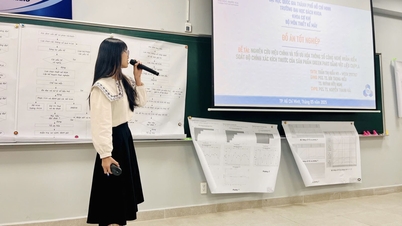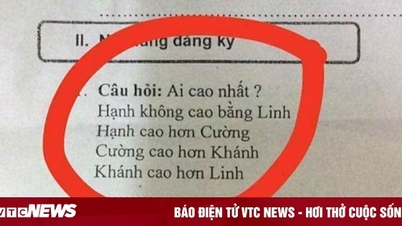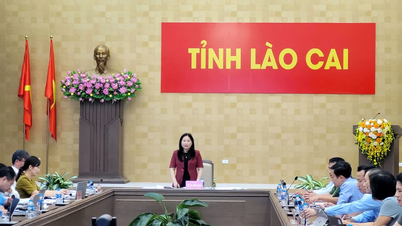The Ministry of Education and Training issued the Regulations on University and College Admissions for Preschool Education in 2025 with the following provisions: Equivalence conversion is the conversion of the entrance threshold and admission score between admission methods and admission combinations of an admission code according to a rule prescribed by the training institution, ensuring equivalence in the level of meeting the entrance requirements of the corresponding training program, major, and group of majors... with the aim of ensuring fairness in university admissions by different methods of universities from 2025. Is this score conversion in line with the set purpose?

Equivalent point conversion rules
In the draft of the 2025 University Admission Guidelines, the Ministry of Education and Training has proposed a formula for converting scores of admission methods for training institutions to refer to. The Ministry of Education and Training requires schools that use multiple admission methods to develop rules for converting scores equivalent to the entrance threshold and admission scores to ensure compliance with the admission regulations, in which the contents are implemented consistently according to the Ministry's instructions.
The Ministry of Education and Training has determined the goal of simple equivalent score conversion rules, ensuring the selection of candidates who best meet the input requirements of training programs, majors, and groups of majors.
The Ministry of Education and Training requires that the conversion of scores must have a scientific and practical basis, including statistical data information and analysis of the learning outcomes of admitted students according to the combinations and annual high school graduation exam scores.
Information on the detailed score distribution of schools organizing the exam, academic results (if the school uses the admission results); use of the admission scores (including the total score of the combination/assessment results... and bonus points) to determine the conversion rules; announce the admission scores for candidates according to each admission method.
According to the guidance of the Ministry of Education and Training, schools use high school graduation exam score data or high school transcript data as the basis for building conversion rules. Based on statistical data, analyze the learning outcomes of students admitted according to the combinations of previous years. Specifically: Statistics on the number of candidates admitted according to each admission method for at least 2 consecutive years; learning outcomes of each student at the school.
Based on the analysis of the correlation between the school's academic performance and the score distribution of the admission methods of the same group of candidates; from the threshold to ensure input quality to the maximum score of the assessment scale, the school must determine at least 3 score ranges (for example: excellent - good, fair and pass) to build at least 3 linear correlation functions (3 first-order functions) for these 3 score ranges.
Construct a conversion table and interpolate the continuous linear correlation function between the scores of the two admission methods (using the method of considering high school graduation exam results as the basis).
The specific conversion table is as follows:

The corresponding linear correlation function is:

Satisfy f(Ak) = Bk. From there determine the correlation coefficients Mk, Nk.
Based on the above plan, and at the same time, based on the standard rules announced by the Ministry of Education and Training after the results of the 2025 high school graduation exam are available, schools will base on the specific characteristics of the training program/major/group of majors to complete the school's conversion rules and announce them according to regulations.
According to the instructions on the conversion method above, it is easy to see that the conversion of scores from competency assessment exams, thinking assessment exams, academic transcript scores, etc. is based on high school graduation exam scores to convert according to a linear function of the first degree to determine the conversion coefficients to unify the final conversion score used to consider the overall score for candidates.
Need to ensure fairness?
Looking at the conversion method, which demonstrates fairness through an intermediate exam score organized by the Ministry of Education and Training on a national scale, it will have high reliability. However, the reliability of high school graduation exam scores, even if high, but the value of the conversion is not there, then this conversion lacks scientific basis and leads to unfairness in university admissions for the following reasons:
Firstly, the conversion does not comply with the science of testing and evaluating learners' results because each exam, test, and subject has different purposes, objectives, and ways of using results according to the purpose of the exam.
For example, the high school graduation exam is mainly for high school graduation and therefore only 5 points/subject is needed to graduate from high school and according to a different standard (5 points or more is passed, so 5 points is like 10 points if only for high school graduation). The ability assessment and thinking assessment tests of universities and colleges are exams with the purpose of university admission and have elements to assess specific abilities for majors at the university level that students can study successfully in the future.
In addition, the final score of the student's study by transcript is the assessment score based on the student's learning process in accordance with the purpose of Circular 22 on testing and evaluating the training and learning results of students with the purpose of evaluating the student's progress, which is different from the purpose of the graduation exam which is the final assessment.
Second, the conversion according to the instructions of the Ministry of Education and Training is a one-way linear conversion without the opposite direction. In particular, for the capacity assessment tests, thinking assessment tests... when converted according to the high school graduation exam scores, the conversion selection sample does not ensure representativeness and considering the influencing factors to give correlations does not ensure fairness for the reason that the specific nature of the 2018 general education program, students study and take the high school graduation exam does not have all the subjects according to the admission combination of schools that use capacity assessment test scores for conversion, so using 3 high school graduation exam subjects for conversion will not ensure comprehensiveness and equivalence in capacity to ensure fairness in conversion.
Furthermore, many candidates who have taken the competency assessment and thinking assessment exams and have had good results are confident that when they take the high school graduation exam, they will not do their best (only need a score of 5 to graduate), so these are also large errors in conversion according to the method instructed by the Ministry of Education and Training.
So, is the conversion of scores according to the above method fairer than the desire of the Ministry of Education and Training compared to the number of quotas for each admission method that universities and colleges prescribe? If the quotas are not fair in determining the admission methods of universities and colleges, the state management agency has many measures to ensure fairness in this admission while still ensuring the autonomy of universities in admission according to the provisions of the Law on Higher Education.
Source: https://daibieunhandan.vn/lieu-co-cong-bang-trong-quy-doi-diem-xet-tuyen-dai-hoc-nam-2025-post409112.html


![[Photo] The 5th Patriotic Emulation Congress of the Central Inspection Commission](https://vphoto.vietnam.vn/thumb/1200x675/vietnam/resource/IMAGE/2025/10/27/1761566862838_ndo_br_1-1858-jpg.webp)

![[Photo] Party Committees of Central Party agencies summarize the implementation of Resolution No. 18-NQ/TW and the direction of the Party Congress](https://vphoto.vietnam.vn/thumb/1200x675/vietnam/resource/IMAGE/2025/10/27/1761545645968_ndo_br_1-jpg.webp)

![[Photo] National Assembly Chairman Tran Thanh Man receives Chairman of the House of Representatives of Uzbekistan Nuriddin Ismoilov](https://vphoto.vietnam.vn/thumb/1200x675/vietnam/resource/IMAGE/2025/10/27/1761542647910_bnd-2610-jpg.webp)






































































































Comment (0)